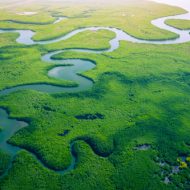Wetlands
Home » Wetlands
Flooding bulwarks and climate stabilisers
Often overlooked, wetlands assume a key role in nature and bring many benefits to human existence. Above all, wetlands absorb large amounts of carbon and other greenhouse gases from the atmosphere. They provide flood control by storing water during heavy rainfall and slowly releasing it into streams and rivers and regulate the climate by releasing water vapour into the air, cooling the surrounding area and reducing the severity of heat waves.Main threats
Habitat destruction
Wetlands are often drained or filled in for development, agriculture, and other human uses. This can destroy or fragment the habitat, making it difficult for wetland plants and animals to survive.
Pollution
Wetlands can be contaminated by pollutants such as chemicals, sewage, and agricultural runoff, which can harm or kill wetland plants and animals.
Climate change
Rising sea levels, changing precipitation patterns, and increased temperatures can all have a negative impact on wetlands.
Invasive species
Non-native plants and animals can outcompete native species and disrupt wetland ecosystems.
Overuse
Recreational activities such as boating, fishing, and hunting can damage wetlands if not managed properly.
Dams & water management
These can alter the flow of water and sediment, which can have a negative impact on wetland health.
Natural disasters
Floods, hurricanes, and other natural disasters can cause significant damage to wetlands and can be intensified by human activities such as e and land use changes.
Key solutions

Regulatory protection
Wetlands can be protected by federal, state, and local laws and regulations. (for example, the Clean Water Act and the Wetland Protection Act in the United States).

Purchase or acquisition
Wetlands can be protected by purchasing or acquiring them from willing sellers or donors. This can be done by governments, non-profit organisations, or private individuals.

Restoration
Through a variety of techniques such as removing invasive species, re-establishing native plants, and improving water flow.

Education and awareness
Raising public awareness about the importance of wetlands and their ecological value can help to promote their protection and preservation.

Community-based conservation
Working with local communities to identify and protect wetlands, and engage them in the management and monitoring of the wetlands.

International cooperation
The Ramsar Convention on Wetlands is an intergovernmental treaty that provides a framework for national action and international cooperation for the conservation and wise use of wetlands and their resources.